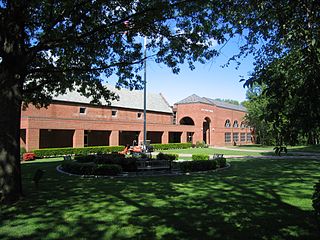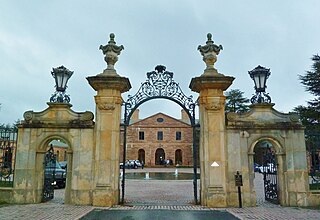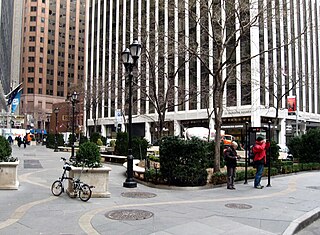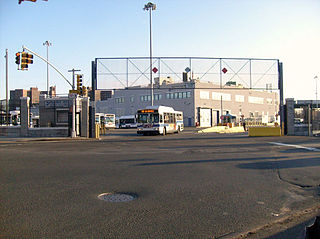
Prall's Island is an uninhabited island in the Arthur Kill between Staten Island, New York, and Linden, New Jersey, in the United States. The 89-acre (0.36 km2) island is one of the minor islands that are part of the borough of Staten Island in New York City.

Stapleton Heights is a neighborhood in northeastern Staten Island, New York City. It stands on the second of a series of hills that form a "backbone" running diagonally across the island from northeast to southwest, between Ward Hill and Grymes Hill; to the east is Stapleton, which is along the waterfront. It is an upper-middle-class enclave noted for its large older one-family homes, and for its view of Upper New York Bay and the Verrazano Narrows Bridge. Many of the grander homes of the neighborhood were constructed in the late 19th century by the families who controlled the industries along the waterfront, including the breweries that operated there until the last one closed in 1963. One such home, on Louis Street, is allegedly "haunted," according to local residents.

Castleton is a former town in the U.S. state of New York. It was located in the northeastern part of Staten Island prior to the incorporation of Staten Island into New York City in 1898. It had a total area of 3880 acres (16 km²) and was bounded by Upper New York Bay on the east and the Kill Van Kull on the north.

St. George Cricket Grounds or St. George Grounds is a former baseball venue located on Staten Island, New York. St. George was the home park for the New York Metropolitans of the American Association for the 1886 and 1887 seasons. The grounds were also a part-time home to the New York Giants of the National League in 1889.

Annadale is a middle-class neighborhood on the South Shore of the borough of Staten Island in New York City.
Willowbrook is a neighborhood in Staten Island, one of the five boroughs of New York City. It is located in the region of the island usually referred to as Mid-Island, immediately to the south of Port Richmond, to the west of Meiers Corners and Westerleigh, to the north of New Springville, and to the east of Bulls Head.

Concord is a neighborhood located in the borough of Staten Island in New York City, New York, United States.
Shore Acres is a neighborhood of Staten Island, one of the five boroughs of New York City. It is situated along the Upper New York Bay, just north of Fort Wadsworth and south of Rosebank. Shore Acres is generally considered to be bounded by Bay Street on the west, the Upper New York Bay on the east, Nautilus Street on the north, and Arthur Von Briesen Park on the south.

Spiro Sports Center is a 2,100-seat multi-purpose arena located on the campus of Wagner College in Staten Island, New York. It was built in 1999 as an extensive addition to the Sutter Gymnasium, which was constructed in 1951. The center is home to the Wagner College Seahawks men's and women's basketball team. The Northeast Conference men's basketball tournament was held there in 1999, 2003, 2016, and 2018

Jasna Polana is the former 226-acre estate of John Seward Johnson I and his third wife, Barbara Piasecka Johnson, located at 4519 Province Line Road in Princeton, New Jersey. In 1998 Jasna Polana became a private country club.
Vanderbilt Avenue is the name of three thoroughfares in the New York City boroughs of Brooklyn, Manhattan, and Staten Island. They were named after Cornelius Vanderbilt (1794–1877), the builder of Grand Central Terminal in Midtown Manhattan.

Hanover Square is a square with a public park in the Financial District, Lower Manhattan, New York City. It is triangular in shape, bordered by Pearl Street, Stone Street and a street named Hanover Square. Most surrounding buildings are primarily commercial.

Centre Street is a north–south street in the New York City borough of Manhattan, running through the Civic Center, Chinatown, and Little Italy neighborhoods of Lower Manhattan. It conencts Park Row to the south with Spring Street to the north, where it merges with Lafayette Street. Centre Street carries northbound traffic north of Reade Street and two-way traffic between Reade Street and the Brooklyn Bridge.

Richmond University Medical Center is a hospital in West New Brighton, Staten Island, New York City. The hospital occupies the buildings that were formerly St. Vincent's Medical Center, which closed in 2006. It is affiliated with the Icahn School of Medicine at Mount Sinai and the Mount Sinai Health System.

The New York Coliseum is a defunct sports venue and auditorium in the West Farms section of the Bronx, New York City. The 105,000-square-foot (9,800 m2) auditorium was originally built for Philadelphia's 1926 Sesquicentennial Exposition, and transported in 1928 to Starlight Park at 177th Street and Devoe Avenue. As such, it was also referred to as Starlight Park Stadium.
The Gallatin Bank Building was constructed in 1887 on a plot at 34 Wall Street in the Financial District of Manhattan, New York City. It was enlarged from an original plot bought at 36 Wall Street when the bank was organized in 1829. The purchase price was $12,000. Originally called National Bank, the name was later changed to Gallatin because of its association with the family of Albert Gallatin. The architects were Cady, Berg & See.

Old Town is a neighborhood in the New York City borough of Staten Island, located on its East Shore. Old Town was established in August 1661 as part of New Netherland, and was the first permanent European settlement on Staten Island. Originally described as "Oude Dorpe", much of its original territory makes up what is present-day South Beach, with parts of Midland Beach and Dongan Hills. The area was settled by a group of Dutch, Walloon and French Protestants (Huguenots) led by Walloon Pierre Billiou.
The Rogers Peet Building is an eight-story building in the Civic Center and Tribeca neighborhoods of Manhattan, New York City. Built between 1898 and 1899, it replaced a five-story structure that was home to the Rogers Peet clothing store between 1863 and 1898, when the original structure burned down.

Ingram Woods is a 3.7-acre forest preserve in the Westerleigh neighborhood of Staten Island, New York, bound by Warwick Avenue, Purdy Avenue, Ingram Avenue, and Gannon Avenue North. The streets around Ingram Woods Park were laid out in 1907 by the firm of Wood, Harmon & Co. for the planned community of South New York. The properties were offered at the bargain price of $190, but because of the neighborhood's isolated location, only a few homes were built by the time that the City began laying out the Staten Island Expressway.

The City Hotel (1794–1849) stood at 123 Broadway, occupying the whole block bounded by Cedar, Temple, and Thames Streets, in today's Financial District of Manhattan, New York City. It was the first functioning hotel in the United States. Until the early 1840s it was the city’s principal site for prestigious social functions and concerts. Designed by John McComb Jr., it offered not only luxurious accommodations, but also such amenities as shops, a barroom, and a coffeehouse, as well as public dining and dancing. Its five stories and 137 rooms replaced the former home of Stephen Delancey, built around 1700, which had become an inn.















